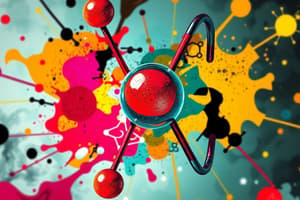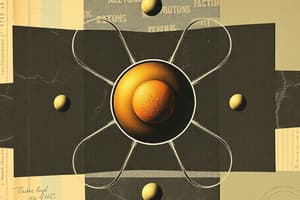Podcast
Questions and Answers
What component of an atom is located at the center and has a positive charge?
What component of an atom is located at the center and has a positive charge?
- Electrons
- Nucleus (correct)
- Neutrons
- Protons
What defines an element in terms of atomic structure?
What defines an element in terms of atomic structure?
- The number of neutrons it contains
- The arrangement of electrons
- The sum of protons and neutrons
- The number of protons it has (correct)
What is the term for atoms that have the same number of protons but different numbers of neutrons?
What is the term for atoms that have the same number of protons but different numbers of neutrons?
- Atoms
- Ions
- Isotopes (correct)
- Elements
Which of the following best describes the atomic mass number?
Which of the following best describes the atomic mass number?
What organization system is used to arrange elements based on similar properties?
What organization system is used to arrange elements based on similar properties?
Which of the following isotopes is commonly used to date geological materials?
Which of the following isotopes is commonly used to date geological materials?
What does the atomic number of an element represent?
What does the atomic number of an element represent?
How many naturally occurring elements are there approximately?
How many naturally occurring elements are there approximately?
What is the significance of isotopes in practical applications?
What is the significance of isotopes in practical applications?
What are atoms with the same atomic number but different atomic mass numbers called?
What are atoms with the same atomic number but different atomic mass numbers called?
Which statement is true regarding the arrangement of elements in the periodic table?
Which statement is true regarding the arrangement of elements in the periodic table?
What does the atomic mass number indicate?
What does the atomic mass number indicate?
Flashcards are hidden until you start studying
Study Notes
Atomic Structure
- Atoms are the smallest particles of an element.
- The nucleus, located at the center of an atom, contains positively charged protons and usually uncharged neutrons.
- Negatively charged electrons orbit the nucleus.
Elements and Classification
- Atomic number is defined as the number of protons in an element.
- Elements are characterized by their atomic number, determining their unique identity.
- Approximately 90 naturally occurring elements exist, with 23 having been synthesized.
- The periodic table organizes elements by grouping those with similar properties in vertical columns.
Atomic Mass Number and Isotopes
- Atomic mass number is the total of protons and neutrons in the atomic nucleus.
- Isotopes are variants of atoms that have the same number of protons but differ in the number of neutrons, resulting in different atomic mass numbers.
- Differences between isotopes can provide unique applications or benefits, often utilized in various scientific fields.
Applications of Isotopes
- Radioactive isotopes, such as carbon-14, are instrumental in dating geological materials and historical events.
Atomic Structure
- Atoms are the smallest particles of an element.
- The nucleus, located at the center of an atom, contains positively charged protons and usually uncharged neutrons.
- Negatively charged electrons orbit the nucleus.
Elements and Classification
- Atomic number is defined as the number of protons in an element.
- Elements are characterized by their atomic number, determining their unique identity.
- Approximately 90 naturally occurring elements exist, with 23 having been synthesized.
- The periodic table organizes elements by grouping those with similar properties in vertical columns.
Atomic Mass Number and Isotopes
- Atomic mass number is the total of protons and neutrons in the atomic nucleus.
- Isotopes are variants of atoms that have the same number of protons but differ in the number of neutrons, resulting in different atomic mass numbers.
- Differences between isotopes can provide unique applications or benefits, often utilized in various scientific fields.
Applications of Isotopes
- Radioactive isotopes, such as carbon-14, are instrumental in dating geological materials and historical events.
Studying That Suits You
Use AI to generate personalized quizzes and flashcards to suit your learning preferences.




